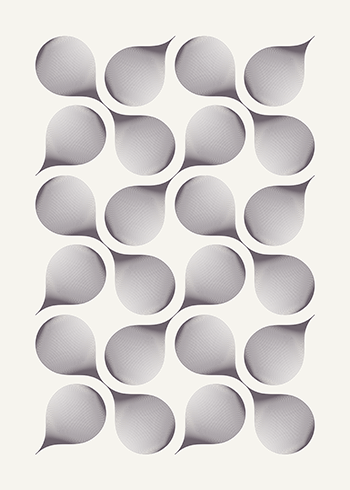

They can convey a sense of vitality, energy, and emotion. They may resemble the shapes of leaves, flowers, waves, or animal forms.

Organic shapes are derived from the natural world, taking inspiration from elements such as plants, animals, clouds, rocks, and human figures. Their flowing lines, irregular contours, and subjective interpretations make them an engaging and expressive visual element.

The characteristics of organic shapes reflect the beauty, complexity, and irregularity observed in the natural world. They can also create a sense of movement and rhythm within a composition. The flowing lines and natural references can evoke feelings of calmness, serenity, energy, or dynamism. Organic shapes have the ability to convey emotion and mood. This complexity adds visual interest and depth to organic shapes. They can contain multiple curves, twists, and turns, reflecting the intricate patterns found in nature. Organic shapes can range from simple and minimalistic forms to complex and intricate designs. This ambiguity allows for individual perception and imagination. Due to their fluid and less defined nature, viewers may see different objects or images within the same organic shape. Organic shapes leave room for subjective interpretation and personal connection. They can evoke a sense of comfort and relaxation. The absence of sharp angles and straight lines contributes to their gentle and less rigid appearance. Organic shapes often have a soft and smooth visual texture. This connection to the organic world gives them a sense of life and vitality. They may resemble the shapes of leaves, flowers, shells, or other natural objects. Organic shapes draw inspiration from elements found in nature, such as plants, animals, water bodies, clouds, or human figures. This irregularity contributes to their natural and free-flowing appearance. They may have variations in size, shape, and contour. Unlike geometric shapes, which are precise and symmetrical, organic shapes tend to be irregular and asymmetrical. The curves in organic shapes often emulate the natural flow and movement found in the environment. They lack sharp angles or straight edges commonly found in geometric shapes. Organic shapes are characterized by smooth, flowing lines and curves. They have been employed in representational, decorative, and abstract art, showcasing their versatility and enduring appeal in artistic expressions across cultures and time periods. Throughout art history, organic shapes have been used to convey a connection to nature, express emotions, and explore the beauty and complexity of the world. They are also utilized by contemporary artists in various mediums.

Greek and Roman sculptures incorporated organic shapes in the depiction of human figures and drapery curtains. Organic shapes were prevalent in ancient Egyptian, Greek, and Roman art. In prehistoric cave paintings and rock art, organic shapes were often used to depict animals, human figures, and natural scenes. The use of organic shapes in art can be traced back to ancient times, with various cultures incorporating natural forms into their artistic expressions. They can be found in various art forms, including paintings, sculptures, architecture, product design, and graphic design, providing a visually engaging and expressive element in creative expressions. They are inspired by various natural elements, such as plants, animals, bodies of water, or geological formations. They are often characterized by soft, curving lines and contours, lacking the precise angles and symmetry associated with geometric shapes. Organic shapes refer to shapes that are irregular, free-flowing, and asymmetrical, resembling forms found in nature. They contrast with shapes in geometry, which are typically precise, regular, and symmetrical.
#5 organic shapes free#
Organic shapes, also known as biomorphic or curvilinear shapes, are irregular, free form shapes, and often asymmetrical forms that are reminiscent of objects found in nature.


 0 kommentar(er)
0 kommentar(er)
